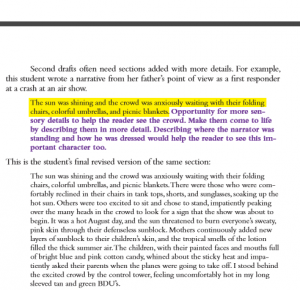Calling All Brown Baggers
 For this month’s Brown Bag event, Professor Dunn and several graduate students presented some methods and techniques on how to effectively respond to student writing. Professor Dunn began by identifying some advice for instructors which is also summarized here.
For this month’s Brown Bag event, Professor Dunn and several graduate students presented some methods and techniques on how to effectively respond to student writing. Professor Dunn began by identifying some advice for instructors which is also summarized here.
Graduate students then offered a variety of suggestions based on current educational research. Below are some of the key points from their presentations. If you’re interested in reading more about our talented graduate students, check out their biographies.
Alternative Modes and Methods
Linnea Conelli discussed some goals, methods, and alternatives available for instructors. She emphasized research done by Dr. Joseph S. Moxley, a professor at the University of Florida, who encourages students in his composition classes to grasp the metacognitive aspects of understanding instructor comments. Moxley also reinforces the significance of using formative methods that encourage instructor/student communication. He provides his students with multiple drafting opportunities and with peer review sessions in order to allow students the opportunity to evaluate others while being evaluated themselves. Linnea stressed that Moxley’s research emphasizes the ways in which instructors should avoid overburdening students with editing mark-ups. He suggests that instructors, instead, should mark dominant patterns of error within student writing.
 In addition, Linnea focused on Moxley’s emphasis on recorded evaluations as an alternative mode of response. By creating an oral/aural way to connect with students, recorded evaluations allow instructors the opportunity to offer substantive responses to student writing instead of just editing for pesky grammatical errors.
In addition, Linnea focused on Moxley’s emphasis on recorded evaluations as an alternative mode of response. By creating an oral/aural way to connect with students, recorded evaluations allow instructors the opportunity to offer substantive responses to student writing instead of just editing for pesky grammatical errors.
Sounding Out and Working Out Instructor Comments
Meghan Buckley’s presentation further recognized the instructor/student relationship through recorded responses to student writing. Using the research of Jeff Sommers, a professor at West Chester University, Megan explained how an audio response to student writing is representative of an ongoing conversation between student and instructor. Audio conversations allow for an individualized dialogue that creates a more authentic experience for students and teachers alike.
Meghan also focused on the benefits of tone provided by a recorded dialogue. According to Sommers, students often feel encouraged by the conversational tone of spoken comments rather than by the often ambivalent written comments given by instructors.
Based on the research, audio responses tend to manifest in 3 specific ways which create openings for continued learning and communication:
- Retrospective Comments: refer to previous shared experiences in the course
- Synchronous Comments: refer to the current reading experience
- Anticipatory Comments: refer to future shared activities in the course
Responding by using a variety of comments forms a bond between instructors and students, and also forms a link between classroom activities and teacher response.
Meghan reminded us that when we comment, we are still teaching!
A Bit of Showing and Telling
Stephen Pallas demonstrated his technological moxie by creating an oral screencast that discusses the research of Dr. Chris Anson et al., while also demonstrating the methods that their research promotes.
Stephen’s oral interaction in the screencast demonstrates the efficient and effective outcomes of oral communication through technology. Check it out below to hear more about how students react to oral screencast comments about their writing!
Stylistic Conflicts and the Role of the Writing Tutor
Nicole Savage focused on research conducted by our own Dr. Dunn in the English Department. Dr. Dunn’s research relates her past experiences as Director of Utica College’s Writing Center. As found in the article, Nicole discussed some of the complex difficulties that tutors in college writing centers face as they help students understand and implement marginal comments given by other instructors.
Rather than simply correcting minute points of grammar, Dr. Dunn’s research reinforces that writing tutors need to make students aware of current writing debates. Students must be taught how to decipher between different stylistic options. Nicole also discussed how academic hierarchies often make it difficult to challenge the established norms in the field of composition; but, writing tutors must work against those hierarchies!
Both Nicole (and Dr. Dunn) encourage writing tutors to educate students holistically, equipping students with the knowledge to make decisions about controversial writing and grammatical techniques.
Writing Mini-Lessons and Perhaps a Bit of Color
Last but not least, Sara Santos presented on the advantages of utilizing writing mini-lessons in conjunction with student comments as advocated by the research of Dr. Nancy Mack, a professor at Wright State University. Sara explained that instructors should not only produce constructive criticism, but also praise students for what they have done well in their drafts. This praise should be specific, focused and detailed.
Also, the feedback provided in student drafts should be directly connected to the ongoing dialogue within the classroom. This creates a context for the comments and helps students better understand what is being asked of them in the revision. Mini-lessons centered on specific rhetorical/writing elements will give students a clear focus throughout the revision process.
Sara explained, too, how a color-coding system of comments allows for more accuracy and specificity: “Using color to highlight a specific place in the text makes it more likely that students will attend to that particular section in their paper and possibly makes the needed revision” (Mack 251). So, get creative and use a bit of color!
In all, it’s important to think about commenting before you actually comment on student papers. The dialogue that occurs within the classroom should always extend to activities outside of the classroom. This will create a student-centered approach to learning that will also help differentiate instruction while creating sound evaluation practices.
Stay Tuned for the Next Brown Bag Event!
Works Cited
- Anson, Chris et al. “Students’ Perceptions of Oral Screencast Responses to Their Writing: Exploring Digitally Mediated Identities.” Journal of Business and Technical Communication, vol. 30, no 3, 2016, pp. 378-411.
- Dunn, Patricia, “Marginal Comments on Writers’ Texts: The Status of the Commenter as a Factor in Writing Center Tutorials.” Stories from the Center: Connecting Narrative and Theory in the Writing Center, edited by Lynn Craigue Briggs and Meg Woolbright, City Desktop, 2000, pp. 31-42.
- Mack, Nancy. “Colorful Revision: Color-Coded Comments Connected to Instruction.” TETYC, NCTE, March 2013, pp. 248-256.
- Moxley, Joseph M. “Responding to Student Writing: Goals, Methods, Alternatives.”Freshman English News, vol. 17, Spring 1989, pp. 9-11.
- Sommers, Jeff. “Response Rethought…Again: Exploring Recorded Comments and the Teacher-Student Bond.” The Journal of Writing Assessment, vol. 5, no.1, 2012.

